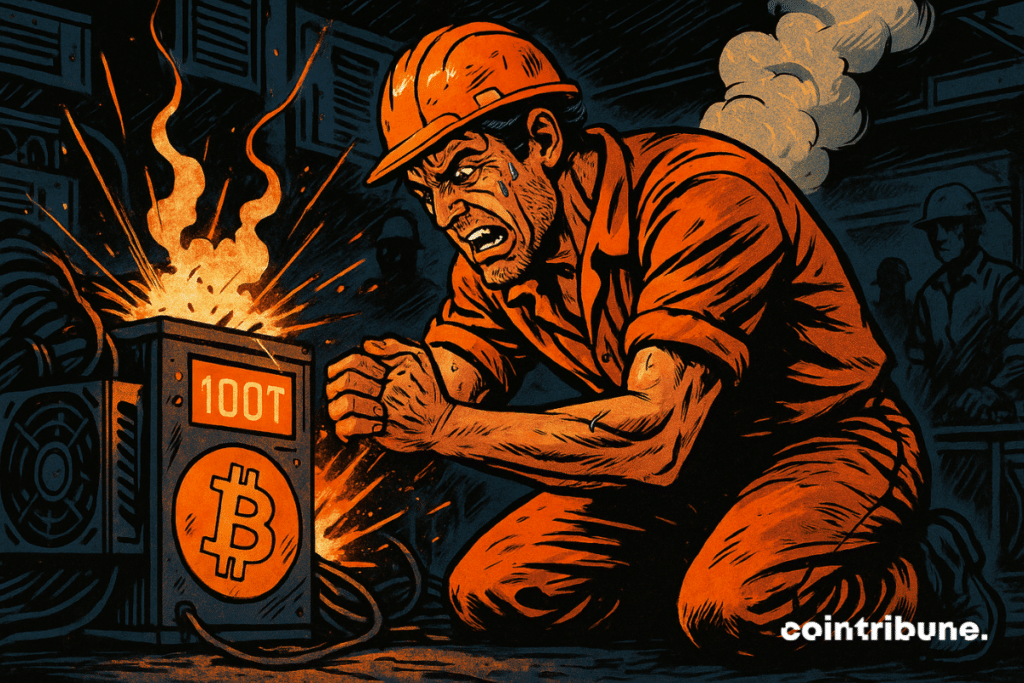Bitcoin Mining Difficulty Hits All-Time High
The Bitcoin network has just crossed a new milestone with a mining difficulty reaching an all-time high of 127.6 trillion. While this figure indicates enhanced security, it raises crucial questions about the sector’s economic balance. Between maintained profitability and a frantic technological race, does this escalation mark the beginning of a new era of mining?

In Brief
- Bitcoin mining difficulty set a new historical record at 127.6 trillion on August 3, 2025.
- The next adjustment scheduled for August 9 is expected to lower this difficulty by about 3%.
- Miners’ revenues surged to $1.66 billion in July, despite increasing technical pressure.
- This rise in difficulty confirms Bitcoin mining’s persistent appeal among professional players.
A Technical Record That Redefines Mining Standards
The difficulty of Bitcoin mining reached a new historical peak on Sunday, August 3, 2025. According to CoinWarz data, it hit 127.6 trillion, a level never seen before. This record was reached at block 908,544 of the blockchain, marking a major turning point for the Bitcoin mining industry.
This surge is no coincidence. Over the last 30 days, difficulty jumped 9.12%, while over 90 days, the rise amounts to 7.14%. This sustained trend reflects the massive arrival of ever more efficient new equipment and the optimization of existing mining farms.
The Bitcoin protocol, thanks to its automatic adjustment mechanism, plays a safeguard role. The more the computing power (hashrate) increases, the higher the difficulty is raised to maintain a block creation pace of every 10 minutes. This self-regulation, unique to the network, guarantees emission stability, regardless of fluctuations in mining power.
Surprisingly, this rise in difficulty coincides with miner revenues at their highest since the 2024 halving. In July, miners earned $1.66 billion, an amount unseen for over a year. The average revenue per exahash stands at $57,400 per day, up 4% compared to June.
Major Implications for the Bitcoin Ecosystem
This technical surge profoundly reshapes the Bitcoin mining economy. Under fierce competition, less efficient players are progressively pushed out, making way for better-equipped, more structured, often industrial operators.
A form of natural selection is taking place, accelerating the sector’s professionalization while strengthening the network’s robustness.
Moreover, combined with persistent institutional demand — notably driven by ETFs, U.S. banks, and corporate treasury strategies — this dynamic creates a strong bullish engine. Bitcoin’s stock-to-flow ratio, already twice that of gold, is further reinforced as a result.
The next adjustment scheduled for August 9 should, however, provide slight relief. Estimates suggest a marginal decrease of 0.03%, bringing difficulty back to 127.29 trillion. A minimal technical correction, but one that could temporarily ease margins for less competitive miners.
Another notable point: the apparent decoupling between rising difficulty and profitability. Despite ever-increasing complexity, miner revenues reach new heights. This suggests the industry has found a new balance, optimizing operating costs to maintain profitability.
In sum, this surge in mining difficulty illustrates the growing maturity of the Bitcoin ecosystem. It reflects a sector in full transformation, where only the most seasoned players survive. This dynamic ultimately strengthens the network’s resilience and its ability to preserve Bitcoin’s scarcity amid growing global demand.
Maximize your Cointribune experience with our "Read to Earn" program! For every article you read, earn points and access exclusive rewards. Sign up now and start earning benefits.
Passionné par le Bitcoin, j'aime explorer les méandres de la blockchain et des cryptos et je partage mes découvertes avec la communauté. Mon rêve est de vivre dans un monde où la vie privée et la liberté financière sont garanties pour tous, et je crois fermement que Bitcoin est l'outil qui peut rendre cela possible.
The views, thoughts, and opinions expressed in this article belong solely to the author, and should not be taken as investment advice. Do your own research before taking any investment decisions.